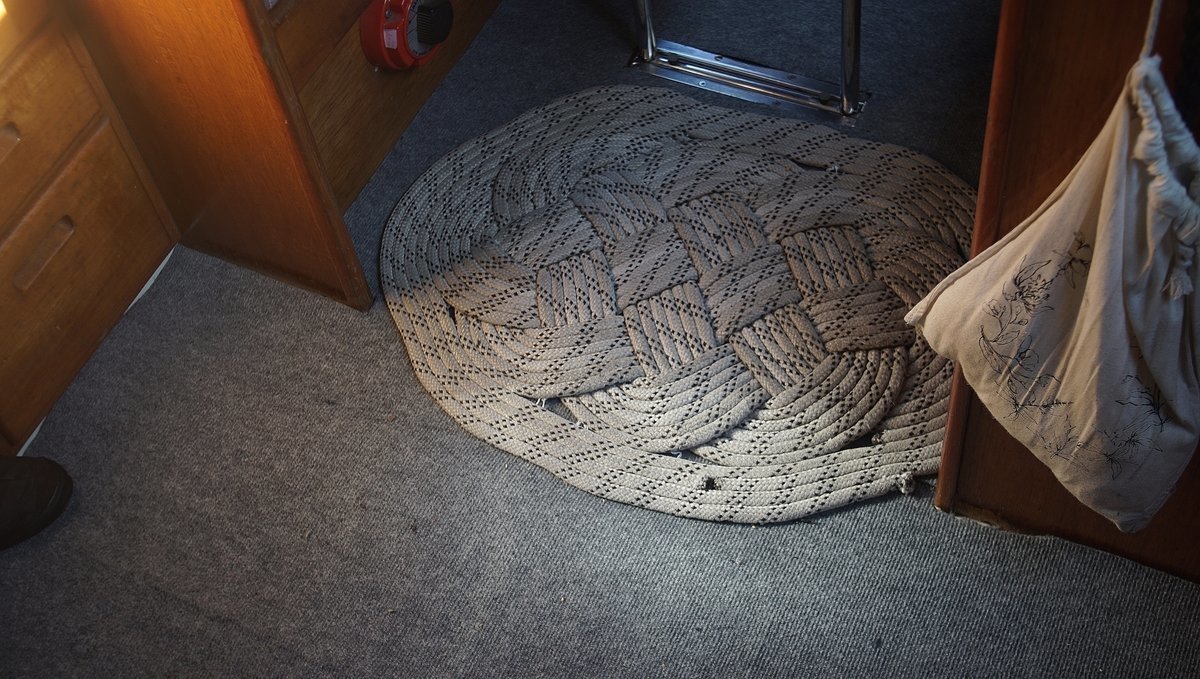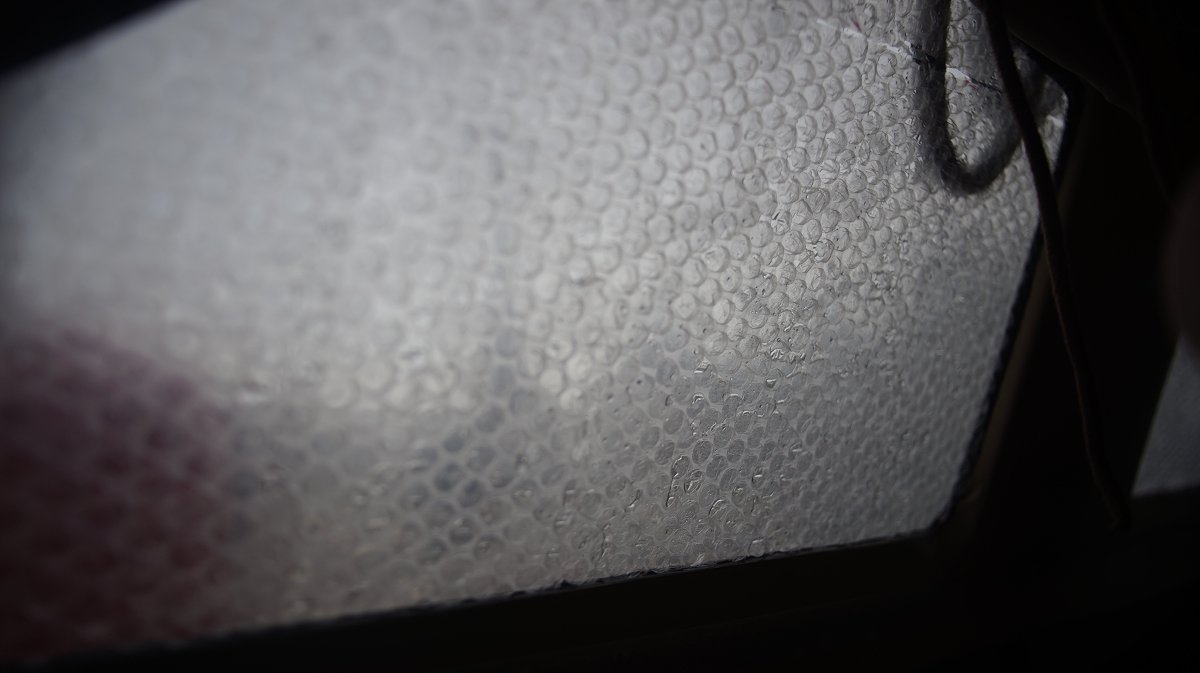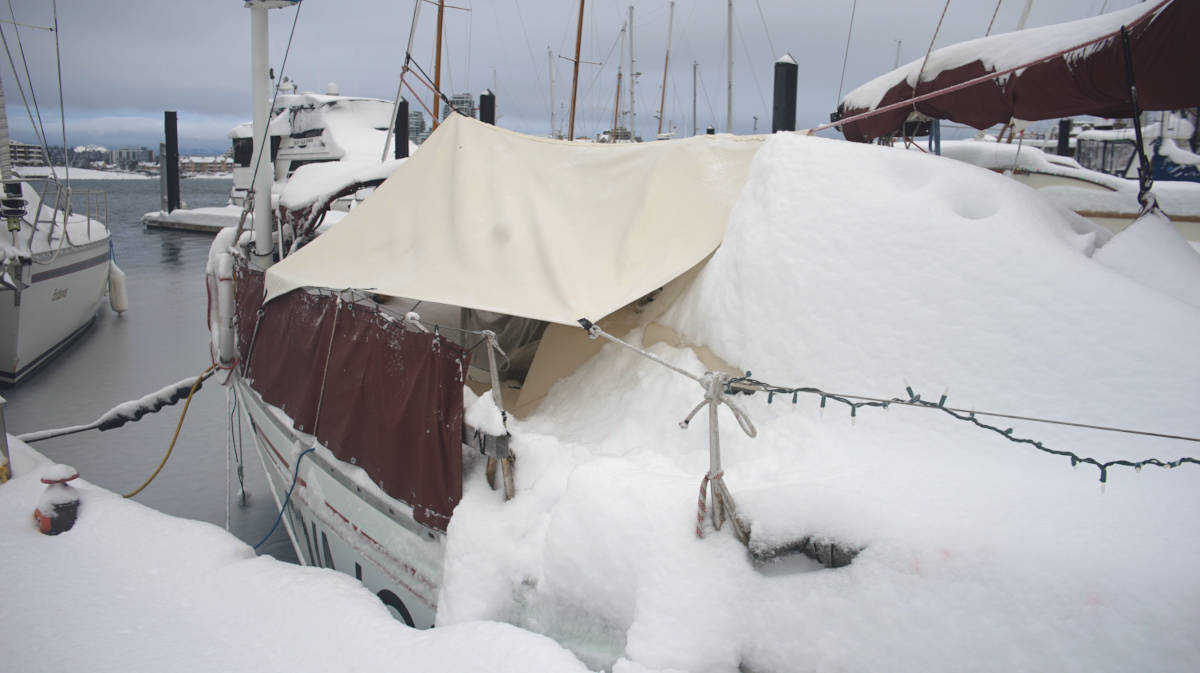winter insulation
Living aboard in areas with hard winters is tricky, especially if your boat is not insulated. And that is a problem since most boats aren't. Condensation in lockers can damage wood, and cause rot and mold. A boat that isn't insulated will cost more to heat. To keep the interior dry, it's necessary to get rid of the moisture generated by cooking and breathing. To dry the space out you need to allow air from outside into the cabin, and then heat it. The heat won't stay if your boat isn't insulated, but winter isn't the time to add insulation, it's better to wait for a drier, warmer season. If you try to use adhesives in cold weather, materials won't bond to the hull.
When we cook, we crack open a hatch to allow the steam to escape. We don't have room for a vented ceiling fan in the galley so this is our best option.
Hull. As stated above, a good winter setup requires both insulation and ventilation in the cabin. Insulation keeps the inside of the boat warm when it is cold out, and ventilation helps to eliminate condensation. Condensation forms because of the difference in temperature and the ambient humidity. There is no miracle solution to eliminating condensation, the only thing to do is to keep the air flowing. Add vents to every locker, every space. If the air moves, moisture won't be as much of an issue.
If you spend a lot of time in very, very cold weather, you will probably want to insulate thicker than 1” to get more R-value.
Insulation options:
Closed-cell spray foam. R-value per inch of R-7. A good way to insulate a hull is polyurethane closed-cell spray foam. Closed-cell foams tend to be water-resistant due to the closed nature of the cells that make up the foam. The more small and compact these cells are, the more resistant to water the material will be. This is how people insulate narrowboats. Closed cell foam is designed to expand to about 1″ of thickness when sprayed. The closed cell also acts as a vapor barrier, so water and moisture won't come through. While insulating, it also provides extra wall strength and buoyancy. The foam is sprayed directly onto the inside of the hull and adheres well to most surfaces. The foam can be trimmed, and sanded (don't breathe the dust). Any foam that is cut loose its waterproof properties, and ought to be sealed. Generally, the foam is covered up with panelling for a nicer, cleaner finish.
Polyisocyanurate foam board. Polyiso has a R-value per inch of R-6. Sold as rigid sheets, these are bonded to the bare hull using a strong adhesive, or spray foam (helps to close gaps). Insulation of this type must be sealed, and well-secured to the backing surface with no air gaps.
Extruded Polystyrene (XPS) Foam Board. A rigid foam board with a R-value of R-5. They are typically blue, or pink(Foamular). Like polyiso, it doesn't retain water but performs better in cold weather. XPS is more bendable than polyiso if you have really curvy walls. XPS manufacturers use HFCs, making this not the greenest option. Can lose its effectiveness over time due to off-gassing, and can retain moisture if exposed for a long time.
Expanded Polystyrene Foam Insulation Boards(EPS). A rigid foam board with a R-value of R-4. EPS boards are more permeable to air and moisture than XPS, but it doesn't retain moisture to the same extent because of it's breathability which lets it dry out. EPS is, in other words, composed of 2% polystyrene and 98% air. The manufacturing process results in a closed-cell structure, but not a closed-cell insulation board (due to voids that can occur between the beads).
What else is there?
- Wool batts. $$. Renewable. Biodegradable. Doesn't rot. Not cruelty-free. Low R-value/inch.
- Rockwool batts. $$$$. Lower R-value/inch. Toxic.
- Fibreglass batts. $. Fairly low R-value/inch. Not waterproof. Toxic.
- Denim batts. $$$. Fairly low R-value/inch. Not waterproof. Non toxic.
- Cork. $$$. Good R-value. Biodegradable. Waterproof. Insect proof. Sustainable.
- Thinsulate. $$$$ Very low R-value/inch. Waterproof. Easy to install. Non-toxic.
What about Reflectix? Reflectix is a reflective insulation which functions best in specific situations. If you do not provide air space, Reflectix has less insulating value. It is useful to insulate areas that are impractical to insulate using other means, say due to lack of space, like around pipes or restricted areas. The product reflects heat back, rather than mass insulation such as the material examples stated above. On a boat, it might be useful to insulate a mast, or outside windows to reflect heat. **Don't place reflectix inside windows, as it can reflect heat back too well and can warp the windows.
To see how we insulated part of Pino, see insulation.
Bilge and floor. For the bilge area, keep it dry and cover the floors with carpet as insulation.

Windows: The windows on our boat are another source of heat loss. We made curtains for each window, and in the winter we add a layer of bubble wrap in between it and the window. The bubble wrap adds a layer of protective insulation, acting as a sort of cheap double glaze. The bubble wrap traps condensation, which ought to then dry in the sun during the day. In our limited experience with liveaboard winters in the Pacific Northwest, the condensation always dries. People told us that mold may form between the bubble wrap and window because of the trapped moisture, but we never had issues with this.

Ceilings: If you can remove panels on your ceiling, install polyiso or XPS foam boards. Like the hull, these panels ought to be glued using spray foam or a high strength spray adhesive. Fill any gaps with polyurethane spray foam.
In the winter, a fresh layer of snow on deck can be a very good insulator. Fresh snow has a lot of air pockets between the ice crystals, which can slow the rate of heat loss inside the cabin.

